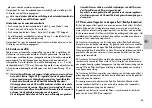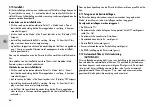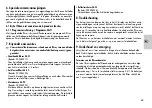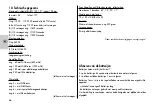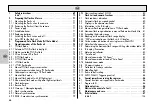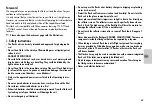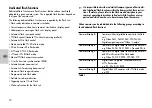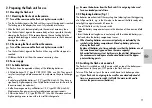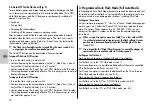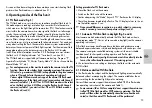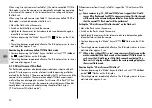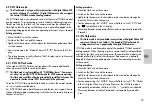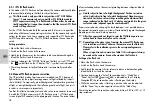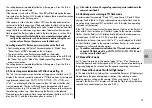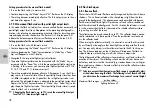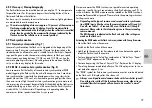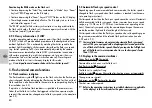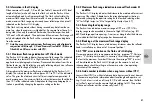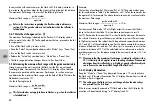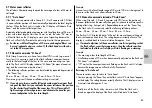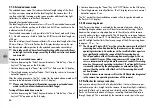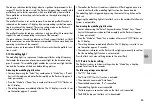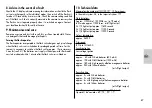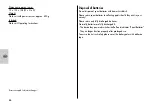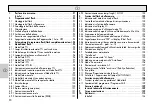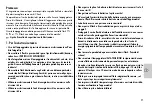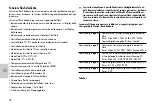
77
ķ
The setting becomes immediately effective. After approx. 5 sec. the LC dis-
play returns to its normal state.
If the camera is used with a CPU lens, then
EV
will flash alongside the aper-
ture symbol on the flash unit’s LC display to indicate that a manual correction
value has been set for flash exposure.
If the camera is used with a lens without CPU, then the adjusted manual cor-
rection value for flash exposure will be displayed on the flash unit in place of
the aperture symbol and the
EV
exposure value. Instead of the maximum flash
range, the flash unit indicates its guide number. To determine the maximum
flash range of the flash unit please refer to the formula given in section 5.4.6.
Many cameras offer the facility to set a manual correction value di-
rectly on the camera. In such an instance we advise setting the cor-
rection value either on the camera or on the flash unit.
Cancelling manual TTL flash exposure correction on the flash unit
• Continue depressing the “Select” key combination (= “Mode” key +
“Zoom” key) until
EV
is indicated on the LC display.
• The set correction value flashes alongside
EV
on the display.
• While the correction value is flashing, set the correction value at
0.0
with
the “Zoom” key or the “Mode” key, thereby cancelling manual TTL flash
exposure correction.
The setting becomes immediately effective. After approx. 5 sec. the LC dis-
play returns to its normal state.
4.5 Correct exposure indication in TTL flash mode (Fig. 4)
The “o.k.” correct exposure confirmation only appears in the flash unit’s LC
display if the shot was correctly exposed in TTL flash mode or its correspond-
ing advanced variants (e.g. 3D-TTL, D-TTL, D-TTL 3D, i-TTL, i-TTL BL, etc.).
If “o.k.” is not displayed after the exposure, then this means that the shot
was underexposed. The shot will then have to be repeated with the next
smaller f-number (e.g. f/8 instead of f/11) or the distance to the subject or
the reflecting surface (e.g. when bouncing the flash) must be reduced.
Please observe the maximum flash range indicated on the flash unit’s LC dis-
play (see 5.4.1) and the information given in section 5.5.
☞
Also refer to section 5.3 regarding correct exposure indication in the
camera’s viewfinder!
4.6 Underexposure warning in TTL flash mode
In certain modes (for example “P” and “A”), some Group C, D and E Nikon
cameras listed in Table 1 will give underexposure warning for flash shots by
way of aperture increments (EV) on the flash unit’s LC display (see operating
instructions of the camera).
If the “OK” correct exposure confirmation does not light up on the flash unit
after a flash shot was taken, or if the flash symbol in the camera viewfinder
flashes, then the flash unit’s LC display briefly indicates the underexposure
value between -0.3 EV and -3.0 EV in one-third increments.
In borderline instances it may occur that “o.k.” is not displayed on the flash
unit but the flash symbol in the camera viewfinder flashes. In such an event
the exposure will nevertheless be correct.
To enable underexposure indication, the TTL mode or an advanced
variant of TTL flash mode (e.g. 3D-TTL, D-TTL 3D, i-TTL, i-TTL BL, etc.)
must be set on the flash unit.
4.7 Manual flash mode
Set “A” aperture priority or the manual mode “M” or “X” on the camera.
Select the aperture and shutter speed (with “M”) on the camera according to
the given photographic situation (see the camera’s operating instructions).
4.7.1 Manual flash mode M with full light output
In this mode the flash unit always fires uncontrolled flashes at full light output.
Adaptation to the given photographic situation is by selecting a corres-
ponding aperture setting on the camera. When using Group C, D and E
cameras, the flash unit’s LC display will indicate the flash-to-subject distance
required for a correct exposure (see also 5.4.2).
☞
☞
Summary of Contents for MECABLITZ 54 AF-1 N
Page 45: ...45 ĸ ...
Page 67: ...67 ń ...
Page 89: ...89 ķ ...
Page 111: ...111 ƴ ...
Page 141: ...141 ...

